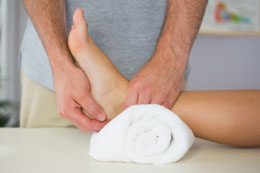Besides sitting for a long time in the same position, bilateral ankle edema can be manifested as a referred sign of other diseases. Treatment for edema on both ankles depends on the underlying causes, and encompasses following self-care tips and taking therapeutic drugs.

Edema, or water retention, is a medical condition characterized by accumulation of water in specific parts of the body, leading to swelling and puffiness. Most commonly affected sites are the extremities, including the hand, leg, ankle and foot. However, it is observed in other parts of the body too. As far as bilateral ankle edema is concerned, it refers to abnormal swelling of both the ankles due to water retention problem.
Causes
The root cause of ankle edema is water buildup in the ankle tissues. It is due to disturbance in the normal circulation of fluids to the bodily parts. This condition is most common in elderly people, pregnant women and those who are having periods. According to medical experts, edema in only one ankle or leg is a medical concern. In comparison to this, the pathology of edema in both ankles is mild and less serious. Listed below are the probable bilateral ankle edema causes.
- Standing or sitting in one position for a longer period is a leading cause for swelling of ankles and legs. Thus, people whose occupation requires prolonged sitting or standing are more likely to develop bilateral ankle swelling than others.
- Consuming foods that contain high amount of salt may lead to excess water buildup in the ankles and legs. Such types of food items include salted snacks, seafood and processed meat products.
- In some, bilateral ankle edema is experienced as a result of medication side effect, or allergy. Drugs belonging to immunosuppressant, anti-inflammatory and vasodilator group may disturb the normal fluid balance.
- Being overweight or obese is also one of the factors that contributes to ankle swelling in both sides. Other probable reasons are physical trauma to the ankles, infections, inflammation, tight casting in ankles and varicose veins.
- It may also be an indication of severe diseases, like lymphatic obstruction, kidney disorders, congestive heart failure, liver cirrhosis, preeclampsia, blood clots and damage of blood vessels. Abnormal functioning of excretory organs (kidneys, liver) causes water accumulation in the ankles and legs.
Treatment
Depending upon what causes swelling of the ankles, it can be a temporary problem or a chronic condition. Say for example, ankle edema manifested after a long flight journey will disappear gradually on its own. However, any case of chronic edema is not a disease by itself. Rather, it is a symptom of some other medical conditions, which bring about retention of water in bodily tissues. Thus, the actual treatment involves diagnosing the root causes, and addressing them with reliable approaches.
Although there is no specific cure for ankle edema, the discomfort symptoms (pain, redness) associated with leg swelling can be treated promptly with the help of self-care tips and therapeutic medications. In case, swelling occurs due to tight casting over leg fractures, removal of the cast is suggested. Taking rest and elevation therapy (placing pillow below ankles) are effective to reduce swelling. If symptom persists, advocating diuretics will help in flushing out excess water from the body. Other prescription medications for swollen ankle treatment include pain relievers and antibiotics.
In order to avoid bilateral ankle edema from occurring, one should not remain standing or sitting in the same position for a long period. Other self-care guidelines that work are, cutting down salt intake and performing movement activities. In case, swelling of the ankles and legs does not reduce after adopting self-care tips and drug administration, get the condition examined by a trusted doctor. The physician will conduct imaging tests for detecting fractures, injuries and blood clots in the affected areas. Treatment options for bilateral ankle swelling will be suggested based on the test results.


 Edema, or water retention, is a medical condition characterized by accumulation of water in specific parts of the body, leading to swelling and puffiness. Most commonly affected sites are the extremities, including the hand, leg, ankle and foot. However, it is observed in other parts of the body too. As far as bilateral ankle edema is concerned, it refers to abnormal swelling of both the ankles due to water retention problem.
Edema, or water retention, is a medical condition characterized by accumulation of water in specific parts of the body, leading to swelling and puffiness. Most commonly affected sites are the extremities, including the hand, leg, ankle and foot. However, it is observed in other parts of the body too. As far as bilateral ankle edema is concerned, it refers to abnormal swelling of both the ankles due to water retention problem.